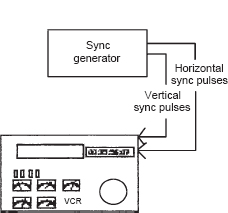Lockup determines how stable a VTR will be.
Other Tracks and Lockup (2)
Vertical Lock (Capstan Servo)
The next level is called vertical lock or capstan servo.This is the minimum degree of lockup for professional production. Capstan servo machines make use of the control track (remember it?) and incoming sync from the sync generator. If you recall, vertical sync pulses are laid down on the control track, and, since they come from the sync generator, they are laid down at very precise intervals. A capstan servo machine is also hooked up to the sync generator and has a special circuit to compare the number of incoming vertical sync pulses from the sync generator with the number of pulses being played back from the control track. Since both pulses ultimately originate from the same source, there should be the same number of pulses in the same amount of time. The vertical sync pulses that come from the sync generator act as a clock. If there are 60 pulses from the sync generator and only 55 from the control track, then the tape is moving too slowly and the capstan servo is signaled to increase the playback speed. But if there are 60 pulses from the sync generator and 63 from the control track, then the tape is moving too fast and the capstan servo is signaled to slow it down.
The big advantage of vertical lock is that a vertical interval switcher will be able to switch to tape from anything without a breakup.
Frame Lock
The next level of lockup is called frame lock and follows the same rule of comparing information from the sync generator with playback information to help regulate tape playback speed. There was no attempt in vertical lock to match an even field pulse with an even field pulse or an odd field pulse with an odd field pulse. That's what the frame lock circuitry does. It determines whether the vertical sync pulse coming from the sync generator is for an odd or an even field. Then it speeds up or slows down the tape machine until the pulses off the control track match: odd for odd and even for even. This makes the tape playback speed just a little more precise.
Horizontal Lock
We now have the fields matched, but each field has 262.5 lines, and each line has a horizontal sync pulse. This leads to the next level of lockup, horizontal lock. The horizontal lock circuitry compares the number of incoming horizontal sync pulses with the number of played-back horizontal sync pulses. The VTR headwheel then speeds up or slows down the tape in an attempt to match the two horizontal pulses.
1. The horizontal lock machine tries to match every horizontal sync pulse played back to a horizontal sync pulse from the sync generator.

